Why not 42?
Doug Adams must have not been an amateur radio operator for he seems to have missed the answer to everything suggesting 42 as the answer to it all.
Perhaps he is right for many things, but for ham radio folks evaluating antenna choices a popular answer for the height of a vertical antenna for the HF bands appears to be 43.
Be sure to check out the many posts about the 43 foot antenna here on this web site.
The 43 Foot Vertical Antenna
If you have been in the market for a vertical you have probably noticed the availability of a “tuner required” vertical which is forty-three feet in height above a reasonable ground plane of radials. Indeed Zero-Five, DX Engineering and others offer this exact configuration in their model lineup claiming “all band” operation from 160 to 10 meters. Can this really be true?
This is also known as a 13 meter vertical. Here is a discussion of why this compromise length exists with some pitfalls.
NEC Simulations of the 43 Foot Vertical
Forgoing the need for a tuner (which is arguably not too big a deal) let’s have a look at the predicted patterns using NEC. To set up the simulation, I copied a vertical antenna with four radials from the Cebik model set available for purchase on his web site. The only thing I changed was the antenna height and the radial length.
- Antenna height = 43 feet AGL with the bottom about 3 inches above ground
- Four Radials of 1/4 wave each to simulate an efficient low impedance ground resulting from layout of many radials
I chose Cebik’s vertical example to ensure I leverage his knowledge of how to model radials reasonably well in NEC which, in my case, uses NEC2 as the engine. NEC2 does not model underground radials so Cebik’s technique is a welcome insertion of NEC2 trickery. Plus, I wanted to capture all the appropriate assumptions he makes for vertical over radials NEC antenna simulations.
The antenna looks like this…
Now here is the predicted patterns using a typical frequency of the main HF bands. Note the “Primary” trace is the one plotted for the 10 meter band…
The peak radiation angles and relative antenna gain for each bands are:
- ~ 5 dBi @ 57° for 10 meters – impressive, but high angle
- ~ 4 dbi @ 37° for 15 meters
- ~ 1 dBi @ 16° for 20 meters – nice low angle
- ~ 0 dBi @ 25° for 40 meters
- ~ -2 dBi @ 29° for 80 meters – this is quite functional
- ~ -8 dBi @ 23° for 160 meters – lossy, but it does work
Several things are apparent:
- The antenna has “better than nothing at all” performance on 160 meters and is certainly interesting for this difficult band.
- Low gain, but good low angle performance is apparent for 80 through 20 meters.
- The 15 meter band shows some actual gain, but at a high angle of about 30-40 degrees – This may or may not be what we want for our DX purposes on this band. That said, it is noteworthy to see it still has unity gain at lower angles.
- The 10 meter band, the black trace marked as Primary, shows peak energy well above 45 degrees elevation. I suspect this will be less than desirable.
10 meters not so hot
You can see why the ten meter case has the high angle radiation when you look at the currents along the vertical as shown here…
The opposing current phases destructively interfere at some angles and constructively interfere at others.
All Band Antenna?
Is this an all HF band antenna? Well, because it operates at no particular “tuned” length for any HF band, except maybe 60 meters, you will always need a tuner. So, sure, it can tune up anywhere the tuner (or matcher if you prefer) can match. If you have to have just one antenna for HF, maybe this is a good choice, especially during the current great low band conditions in this low sunspot point in time.
A better reason to consider this antenna is for reasonable 80-20 meter use and as a practical thing to try for the 160 meter band. Because you can tune almost anything to almost any band, it is possible to get 10 and 15 meter use too with the propagation issues described above.
Other advantages for this 43 foot antenna is expense. You can have one for a few hundred dollars and several major antenna manufacturers, noted above, make them. The variables between the manufacturers is likely strength in materials and other mechanical design issues. Look to Eham for evaluations.
Is the 43 foot a contender?
In my quest for a do it all vertical to replace my 16.6 foot copper pipe my choices include:
- Multiband Fixed Height Vertical using Traps
- Multiband Variable Height Vertical using the SteppIR BigIR III
- Multiband Fixed Height Vertical using an antenna matcher in the shack – such as this 43 foot concept
- Multiband Fixed Height Vertical using an antenna matcher at the antenna base – 43 foot concept again
- Forget the vertical and get a dipole
Because I am getting good results on 20 meters with my 16.6 foot vertical, I am not interested in dipole solution #5… yet. Thus, I desire to bring some closure to this vertical installation and make it the best it can be.
I am still leaning towards the SteppIR BigIR Vertical even though it is a bit expensive. Being able to tune the antenna precisely to the appropriate length is a great feature reducing standing waves on the coax.
However, the simplicity of solution #3 means no additional wires to the antenna to power an automatic remote tuner or drive the SteppIR motor. This is just radio (with built-in matcher), coax, antenna. I lose some power in my very long coax with the standing waves, but have a much more reliable system. Uncomplicated solutions are certainly well worth considering.
No getting around radials
No matter what your choice, if you want a vertical, consider the investment you will need for the radial system. Get the DX Engineering Radial plate and just do it. It really helps.
1:4 Transformer Helps the 43 Foot Antenna
One more point is worth mentioning. The various makers of 43 foot vertical antennas all suggest the use of a 1:4 balun. Some suggest using a balun model made specifically for “tuner use” with the idea these specialized units have the robustness needed to handle the less that ideal voltages and currents. A nice balun costs good coin and is certainly worth it. Just be sure to roll this expense into your trade study when comparing this 43 foot solution with something like the BigIR vertical.
Also watch out for aluminum components near the ground. Certain soil conditions will dissolve aluminum.
DX Engineering and Zero Five Antennas seem to be in hot competition in the vertical market and they both have an approximate 43 foot system to sell you. If you are in the market for this kind of vertical start your trade study with these two manufacturers.
Good luck.
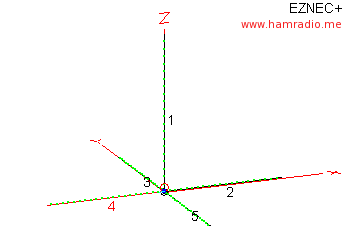
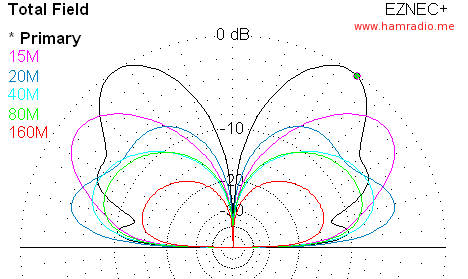
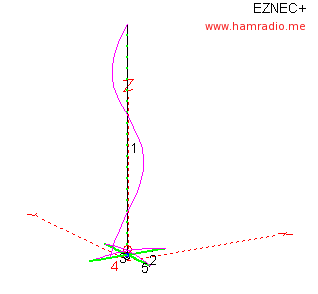

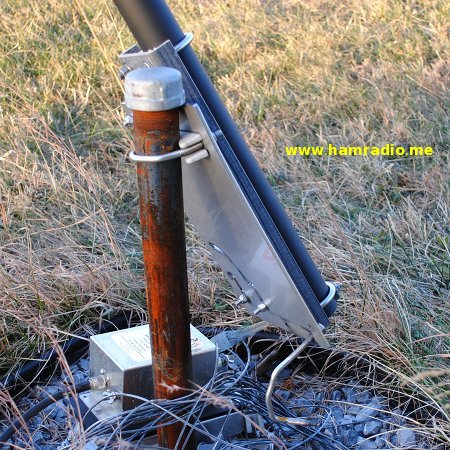
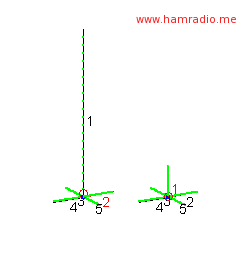
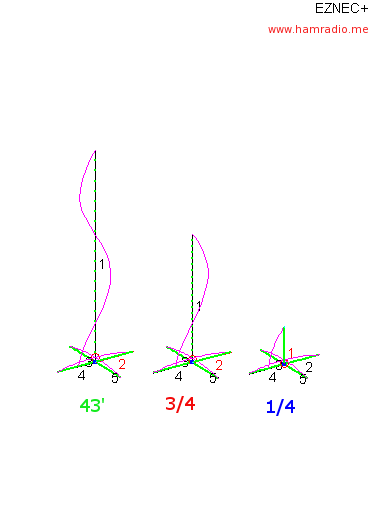
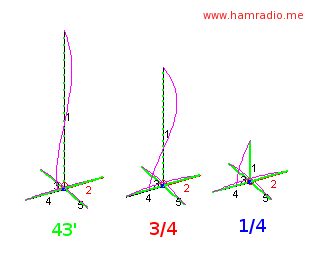
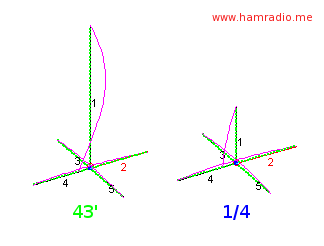
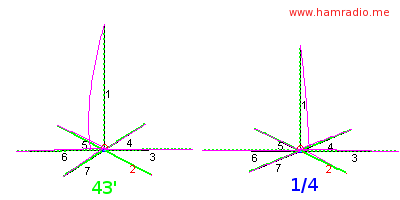
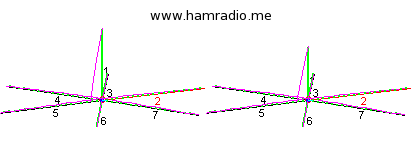
One example of the 43 foot antenna rises in this post…
43 Foot Antenna Installation – The Rising
Hi OM, your comments on the 43 foot vertical very interesting. I want to erect a 43 foot fiberglass whip shortly with a good radial field and SG230 base mounted coupler.
Just wondering if there is any way to "fix" the 10M current distribution problem? Maybe with a series 1/4W coaxial stub around 8 feet long say 16 feet from the top? Might actually provide some extra gain on 10M AND restore the desired low angle radiation?
73, Chris ZL1BOE (reply cbmuir at extra dot co dot nz)
Oops! Two corrections needed to my previous post:
1) My direct address is cbmuir at xtra dot co dot nz
2) Presumably a series stub for 10M would actually be around 4 feet lonh – not eight feet.
73, Chris ZL1BOE
43 ft vertical appears to be the best ''all rounder'' when it comes to 40+80mts bands. Does it work ?? you will be surprised how well it does perform. You need radials and agree a minimum of 6 ….more the better at least 30ft long. Another tip….use a high powered 4:1 Unun. Don't mess about with 100/200 watt versions go for 1kw. This antenna does work. You can try sloping the wire to a fixed point on a building if you haven't got a fibreglass pole.
Hi interesting , does this means you don’t need an antenna tuner? LX1UN
Antenna tuner is still a necessity I'm afraid, but if you hit upon a certain length of feedline, there is likely at least one point where it might tune up just right.
In 1981, long before the commercial versions appeared, I made a 43' vertical, as that length makes it a 5/8th wavelength on 20 meters. Operating it over 100 radials, each 50' long, it proved to be a very good DX antenna. I fed it with individual matching networks on 20, and later 40 and 80 meters, and it worked well on those bands too. It should not be used on higher bands where it is above 3/4 wavelength high. 17 meters is probably that point.
Addendum to my previous post!
Where as, a 1/4 wave vertical on 20 meters begins hearing stations about 400-500 miles away, my 43' vertical began hearing stations about 900-1000 miles away, which means the antenna was deaf to signals above about 25 degrees. Models in NEC 2 and 4 tend to show an exaggerated upper lobe which simply does not exist. If it did, the antenna would hear some of the closer in signals that the 1/4 wave antenna responds to. The 5/8th wave vertical has a deep null at about 25 degrees and a very minor lobe higher, but the minor lobe nose may be above the critical angle.
ive been useing the 43 foot with a 9:1 balun or a 4:1 with 2 or 3 counterpoise wires of 30 foot each .Its been a work horse antenna no issues and works time and time again.useing a ldg100 and ic 706/ic 718/ic 7200 and recently 2 years of the ic7300……..with well over 10 years of useing it I have no complaints it makes the dx rx/tx signals strong and i use 12 g house wire and its just fine.
Thank you for the analysis an interesting article, however, please note that the text for the peak radiation angles and relative antenna gain for each bands do not correspond to the chart.
nutzen Sie doch einfach eine Delta Loopfor 10 m Band wird mit den Abspannungen realisiert ,geht gut